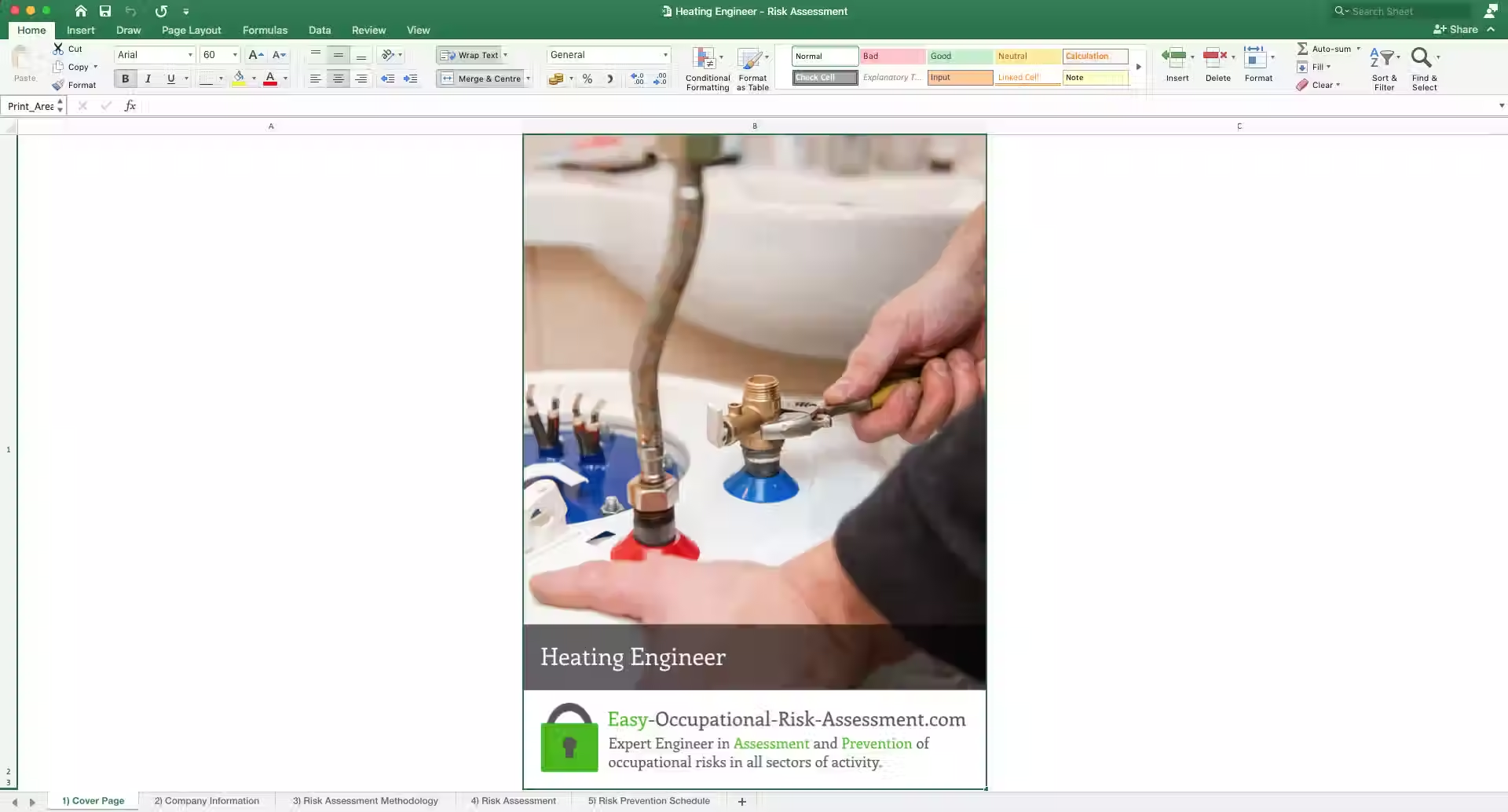Are you a heating engineer?
In search of a health and safety risk assessment tailored to your activity?
Do you need a pre-filled assessment to save you hours of work?
Want to be in compliance with safety regulations?
Our Health and Safety Risk Assessment is designed to meet your needs with:
→ A professional risk assessment totally specific to heating engineers.
→ Risk prevention proposals for heating engineers.
→ A health and safety implementation schedule.
All this in an easily editable Excel format, allowing you to make personalized updates on your own.
FEATURES OF OUR HEALTH AND SAFETY RISK ASSESSMENT FOR HEATING ENGINEERS
This 5-page Excel file includes:
- A Cover Page
- A Company Information page
- A presentation of the Risk Assessment Methodology used.
- An occupational risks assessment tailored to your sector of activity.
- A risk prevention schedule with all the different safety measures.
It contains 35 occupational risk situations classified into 5 work units:
- On site
- On the road
- Office work
- Customer contact
- Working environment
☑ Complies with the employer's obligation to assess risks
(Regulation 3 of the Management of Health and Safety at Work Regulation 1999)
☑ Adheres to the General Principles of Prevention
(Schedule 1 of the Management of Health and Safety at Work Regulation 1999)
☑ Takes into account good practice and pitfalls in risk assessment
(Report RR151 from the Health and Safety Executive)
EXCERPTS FROM OUR HEALTH AND SAFETY RISK ASSESSMENT FOR HEATING ENGINEERS
- Risks associated with carbon monoxide poisoning: Heating engineers regularly have to work on malfunctioning heating systems. One of the dangers associated with this activity is the possibility of working on a boiler with poor combustion, which gives off carbon monoxide (CO). This gas is totally undetectable by the body, as it is odorless (no smell) and colorless (no color), but prolonged inhalation can lead to intoxication. Mainly when working on malfunctioning heating systems. Carbon monoxide risks are present in all combustion systems, whether gas, oil, wood or, more rarely, petroleum. Electrically-powered systems (electric heating, aerothermal heating, geothermal heating, etc.) do not expose people to the risk of carbon monoxide poisoning. Symptoms of acute carbon monoxide poisoning include headaches, dizziness and nausea. This is followed by physical weakness (muscular impotence) and confusion. If the person remains in this vitiated atmosphere, they risk losing consciousness and subsequently falling into a coma. In the worst case, this can lead to death by asphyxiation.
- Risks associated with inhaling combustion dust: Heating engineers regularly have to work on combustion heating systems (wood, oil and gas) to carry out chimney sweeping. Mechanical chimney sweeping involves removing soot and combustion deposits (tar) from the heating appliance's flue, before vacuuming them out with a special device. During chimney sweeping, heating engineers can inhale combustion residues that are harmful to health. The risks are very high during chimney sweeping, but also during any operations likely to suspend combustion residue dust. Sweeping heating ducts without respiratory protective equipment significantly increases the risk of inhalation of these dusts (the minimum requirement is an FFP2 mask. However, FFP3 or cartridge masks are preferable). Soot from the flues of heating appliances contains Polycyclic Aromatic Hydrocarbons (PAHs), classified as proven carcinogens. While inhalation is particularly problematic (lung cancer, cancer of the pleura, irreversible reduction in respiratory capacity linked to pulmonary fibrosis), skin contact is also at risk, with possible skin cancers appearing late in life, after the person has stopped working.
- The danger of hot-spot work: Heating engineers will be working with hot spots during the various welding operations they carry out. Whether welding metals directly to each other, or brazing with a filler metal, high temperatures ranging from 450°C to 1000°C are required. These hot-spot operations entail risks for people working on the site, and for the working environment, with the risk of fire outbreaks. The risks associated with hot-spot work are present as soon as the heating engineer uses his welding unit. If welding/soldering has to be carried out on the customer's premises with surrounding combustive materials, the risk of fire outbreaks is much greater. In most cases, fires start within two hours of hot-spot work, due to the self-ignition of materials by heat (spontaneous combustion). Working with hot spots can lead to fire, with partial or total destruction of the work area, involving considerable financial costs. They can also cause human damage: first-degree burns (erythema: the skin is red, dry and painful), second-degree burns (blisters) and third-degree burns (cardboardy, white or brownish, insensitive skin), or even death.
REGULATORY COMPLIANCE OF OUR RANGE OF HEALTH AND SAFETY RISK ASSESSMENTS
_ We're registered as Professional Risk Prevention Consultants.
_ Our team comprises graduate safety engineers.
_ Our documents are routinely checked by safety inspectors.
RESOURCES ON WORK-RELATED RISKS FOR HEATING ENGINEERS
_ "Plumbing/Gas/Heating Engineer" by Breathe Freely.
Health and Safety Risk Assessment - Heating Engineer
| Already completed Risk Assessment
| Download immediately after purchase
| Refund within 48 hours if you’re not satisfied
| Compliant with UK Health & Safety regulations
| Customisable Excel file
| Printable for paper archiving
| Updated for 2026
| Health and Safety Risk Assessment consultancy
| Covering more than 100 sectors
| Thousands of clients worldwide
| A satisfaction rate of nearly 100%
| Support via email and live chat
| Attentive to your health and safety concerns
| Available to answer your questions












